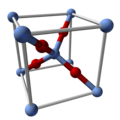Silver oxide

| |

| |
| Names | |
|---|---|
| IUPAC name
Silver(I) oxide
| |
| Other names
Silver rust, Argentous oxide, Silver monoxide
| |
| Identifiers | |
3D model (JSmol)
|
|
| ChemSpider | |
| ECHA InfoCard | 100.039.946 |
| EC Number |
|
| MeSH | silver+oxide |
PubChem CID
|
|
| RTECS number |
|
CompTox Dashboard (EPA)
|
|
| |
| |
| Properties | |
| Ag2O | |
| Molar mass | 231.735 g·mol−1 |
| Appearance | Black/ brown cubic crystals |
| Odor | Odorless[1] |
| Density | 7.14 g/cm3 |
| Melting point | 300 °C (572 °F; 573 K) |
| 0.013 g/L (20 °C) 0.025 g/L (25 °C)[2] 0.053 g/L (80 °C)[3] | |
Solubility product (Ksp) of AgOH
|
1.52·10−8 (20 °C) |
| Solubility | Soluble in acid, alkali Insoluble in ethanol[2] |
| Structure | |
| Cubic | |
| Thermochemistry | |
Heat capacity (C)
|
65.9 J/mol·K[2] |
Std molar
entropy (S⦵298) |
122 J/mol·K[5] |
Std enthalpy of
formation (ΔfH⦵298) |
−31 kJ/mol[5] |
Gibbs free energy (ΔfG⦵)
|
−11.3 kJ/mol[4] |
| Hazards | |
| GHS labelling: | |
  [6] [6]
| |
| Danger | |
| H272, H315, H319, H335[6] | |
| P220, P261, P305+P351+P338[6] | |
| NFPA 704 (fire diamond) | |
| Lethal dose or concentration (LD, LC): | |
LD50 (median dose)
|
2.82 g/kg (rats, oral)[1] |
| Related compounds | |
Except where otherwise noted, data are given for materials in their standard state (at 25 °C [77 °F], 100 kPa).
| |
Silver(I) oxide is the chemical compound with the formula Ag2O. It is a fine black or dark brown powder that is used to prepare other silver compounds.
Preparation

Silver oxide can be prepared by combining aqueous solutions of silver nitrate and an alkali hydroxide.[7] This reaction does not afford appreciable amounts of silver hydroxide due to the favorable energetics for the following reaction:[8]
US patent 20050050990 describes the preparation of AgO with properties suitable for use as a fine grained conductive paste filler.
Structure and properties
Ag2O is isostructural with Cu2O. It is therefore expected that Ag2O is insoluble in all solvents,[10] except by reaction. It is slightly soluble in water due to the formation of the ion Ag(OH)2− and possibly related hydrolysis products.[11] It dissolves in ammonia solution to give soluble derivatives.[citation needed] A slurry of Ag2O is readily attacked by acids:
- Ag2O + 2 HX → 2 AgX + H2O
where HX = HF, HCl, HBr, or HI, HO2CCF3. It will also react with solutions of alkali chlorides to precipitate silver chloride, leaving a solution of the corresponding alkali hydroxide.[12][11]
Like many silver compounds, silver oxide is photosensitive. It also decomposes at temperatures above 280 °C.[10]
Applications
This oxide is used in some silver-oxide batteries, as is the silver(I,III)oxide, Ag4O4. In organic chemistry, silver oxide is used as a mild oxidizing agent. For example, it oxidizes aldehydes to carboxylic acids. Such reactions often work best when the silver oxide is prepared in situ from silver nitrate and alkali hydroxide.
References
- ^ a b c "Silver Oxide MSDS". http://www.saltlakemetals.com. Salt Lake Metals. Retrieved 2014-06-08.
{{cite web}}: External link in|website= - ^ a b c Lide, David R. (1998). Handbook of Chemistry and Physics (87 ed.). Boca Raton, FL: CRC Press. pp. 4–83. ISBN 0-8493-0594-2.
- ^ a b Perry, Dale L. (1995). Handbook of Inorganic Compounds (illustrated ed.). CRC Press. p. 354. ISBN 0849386713.
- ^ a b http://chemister.ru/Database/properties-en.php?dbid=1&id=4098
- ^ a b Zumdahl, Steven S. (2009). Chemical Principles 6th Ed. Houghton Mifflin Company. p. A23. ISBN 0-618-94690-X.
- ^ a b c Sigma-Aldrich Co., Silver(I) oxide. Retrieved on 2014-06-07.
- ^ Janssen, D. E.; Wilson, C. V. (1963). "4-Iodoveratrole". Organic Syntheses
{{cite journal}}: CS1 maint: multiple names: authors list (link); Collected Volumes, vol. 4, p. 547. - ^ Holleman, A. F.; Wiberg, E. "Inorganic Chemistry" Academic Press: San Diego, 2001. ISBN 0-12-352651-5.
- ^ Biedermann, George; Sillén, Lars Gunnar (1960). "Studies on the Hydrolysis of Metal Ions. Part 30. A Critical Survey of the Solubility Equilibria of Ag2O". Acta Chemica Scandinavica. 14: 717. doi:10.3891/acta.chem.scand.14-0717.
{{cite journal}}: CS1 maint: multiple names: authors list (link) - ^ a b Merck Index of Chemicals and Drugs, 14th ed. monograph 8521
- ^ a b Cotton, F. Albert; Wilkinson, Geoffrey (1966). Advanced Inorganic Chemistry (2nd Ed.). New York:Interscience. p. 1042.
{{cite book}}: CS1 maint: multiple names: authors list (link) - ^ General Chemistry by Linus Pauling, 1970 Dover ed. p703-704
External links
- Annealing of Silver Oxide Demonstration experiment: Instruction and video
- Silver Oxide, Ag2O

